Last year I was learning mostly about Honeybee biology and top bar hive natural beekeeping. This year is different; the Honeybees are teaching me about our ecosystem. I'm observing the flowering plants, bushes and trees. I'm observing what what crops my neighbouring farmers are growing and what bushes and trees do they have in their yards. I'm observing the seasonal continuum of this biodiverse ecosystem. The nature is in constant flux. The Honeybee made me see nature with open eyes for the very first time :)
 |
| Dandelions bloom has ceased and the flowers became seeds |
 |
| A Bumblebee working the Chestnut flower |
 |
| Lilac is blooming heavily but I see no Honeybees pollinating it, only Bumblebees. Not sure if Honeybees like it ... |
 |
| Comfrey has begun to flower |



I'm trying a flower called Meadowfoam this year. The bees are supposed to love it. We planted some in the hugulkulture bed as well as by the Echium.
ReplyDeleteWe bought a couple of BeeBee trees. I hope we're still alive when they start to bloom FOUR to SIX years from now, and that we remember where we planted them. :-)
Here are some photos...
http://s1140.photobucket.com/user/john677x/library/?sort=6&page=1